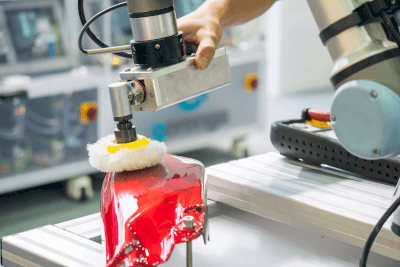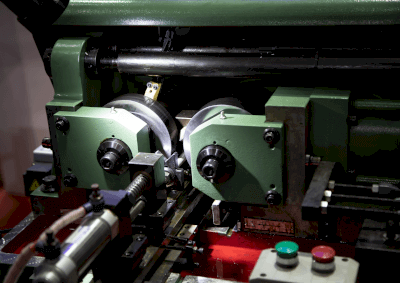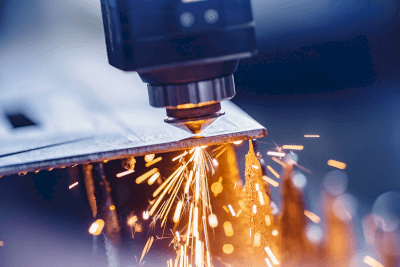ヒートエクスチェンジャーとは
ヒートエクスチェンジャーとは、温度差のある二つの流体の間で熱の移動を行い、流体を加熱・冷却するための装置です。
熱交換機とも言われ、2つの流体には気体と気体、気体と液体、液体と液体の3つの組み合わせがあります。ヒートエクスチェンジャーは装置内部で使用する (消費される) 流体の温度を調節するためと、装置の温度調節に使用した流体の冷却・加熱のために使用します。
流体の温度の調節にヒートエクスチェンジャーが使用される理由は、大きく分けて2つあります。1つ目は装置に送り込む気体や液体の温度を、穏やかに且つ短時間で調整できて、局所的な加熱・冷却による気体や液体の変質を防止できることです。2つ目は、装置内部の限られた空間の中に設置できて、排出物を出さずに熱交換を行えることです。
ヒートエクスチェンジャーの使用用途
ヒートエクスチェンジャーの最もよく知られた例は、自動車のラジエターです。高温になる自動車のエンジンを冷やすために、エンジンの内部には冷却水が循環しています。エンジンを冷やして高温になった冷却水は、ラジエターに入り、空気に熱を奪われて温度が下がり、再びエンジンの冷却のために戻ってゆきます。ラジエターの内部では冷却水と空気の間で熱交換が行われますが、そのために冷却水が消費されたり、空気に他の物質が混ざることはありません。
製造現場で使われるヒートエクスチェンジャーの例としては、半導体の製造過程で使用するプロセスガスを温める例があります。プロセスガスが通る金属の配管を容器の中に通し、その容器を高温に加熱された気体や液体で満たすことで、間接的にプロセスガスを温めます。
その他には、各種分析装置用超高純度ガスの供給、熱処理炉用雰囲気ガスの供給などに使われます。
民生品としては、キャンプ用品の一種で、鍋やヤカンの底に、金属のフィンを付けた調理器具があります。これはフィンを付けることで、炎の熱のうち、従来ならば鍋やヤカンに当たらずに周囲に逃げて行く分の回収を行い、限られた火力でより効率的に料理ができるようにしています。
この調理器具もヒートエクスチェンジャーと呼ばれていますが、ヒートエクスチェンジャー・クッカーとも言われます。この場合は、熱交換という意味合いよりも、バーナーの炎の熱を金属フィンで受け、それを鍋にまで伝えるという熱伝導の仕組みに着目して付けられたものと思われます。
ヒートエクスチェンジャーの原理
温度差のある2つの流体がある場合、その2つが直接に接触しなくても、金属のような熱伝導率の高い物体を挟んで対峙すると、温度の高い流体から温度の低い流体へと熱が伝わります。この原理を利用して、温度調節の対象となる流体の、温度を制御する装置がヒートエクスチェンジャーです。
ヒートエクスチェンジャーは加熱に使用する際にはヒーターの一種であり、冷却に使用する際にはラジエターとも呼ばれています。
流体を加熱する際には、流体が入った容器や配管を、ニクロム線やガスの炎で直接加熱する方法もあります。しかし、その場合には加熱される部分が局所的になり、物質によっては加熱による爆発や発火の危険性もあります。そこで、アルゴンなどの不活性ガスを加熱して容器の中に送り込み、容器の中に加熱対象の流体が流れる金属の管を通すことで、間接的に安全に加熱することができます。
ラジエターの場合は、高温になった流体を金属のフィンがついた金属の管の中を流すことで、熱をフィンを通して空気中に逃がし、流体の温度を下げています。管を何回も折り曲げて集中した箇所を作り、そこにたくさんのフィンを付けることで、小さな空間でより多くの熱を逃がすことができます。
ヒートエクスチェンジャーの選び方
工場や研究所で使用するヒートエクスチェンジャーとしては、工業用のガスを、そのガスがプロセス装置や反応炉に流れ込む直前で、適切な温度に加温するためのヒーターがあります。
被加熱ガスには、人体にとって有害なものが多くあります。また、半導体の製造工程で使用するプロセスガスなどは、他の物質の混入 (コンタミネーション) を厳しく制御しいて、高い純度を保ったままで使用しなければなりません。従って、ヒートエクスチェンジャーには被加熱ガスを常に高い密閉性を保ったまま流し続ける安全性能と、配管の内部に腐食が生じない品質の安定性が要求されます。
それと同時に、被加熱ガスの温度と流量を正確にモニタリングして、渦昇温を防止する機能や、異常時に素早くガスの流れを遮断する機能なども要求されます。
船舶のエンジンを冷却する装置もヒートエクスチェンジャーと言われています。自動車などのラジエターは、熱くなった冷却水をフィンを介して空気中に逃がしています。船舶の場合には、ポンプを使って海水を汲み上げて、エンジンから流れて来る高温になった冷却水の冷却に使用しています。ヒートエクスチェンジャーが壊れると船舶は航行できなくなるので、耐久性とメンテナンス性が求められています。
 A buffing service is a method used to smooth surfaces by eliminating irregularities. This process involves applying abrasives to a buffing wheel, typically made of
A buffing service is a method used to smooth surfaces by eliminating irregularities. This process involves applying abrasives to a buffing wheel, typically made of  Thread rolling is a plastic-forming process where a strong force is applied to a workpiece, causing deformation. The thread-rolling dies press against the rotating workpiece.
Thread rolling is a plastic-forming process where a strong force is applied to a workpiece, causing deformation. The thread-rolling dies press against the rotating workpiece. Steel processing refers to all activities performed on
Steel processing refers to all activities performed on